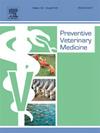整合经验网络数据和基于主体的建模,以检查加拿大安大略省马术运动员的马流感感染风险
IF 2.4
2区 农林科学
Q1 VETERINARY SCIENCES
引用次数: 0
摘要
马匹经常被运输,为病原体的传播创造了机会。由于在描述马的运动和它们的接触网络的结构超越简单的假设的挑战,马传染病的疾病传播模型面临着其普遍性的限制。本研究旨在将马流感疾病动态的随机、基于agent的SEIR模型与观察到的加拿大安大略省马接触网络结构相结合,量化安大略省比赛马在不同条件下爆发马流感的潜在程度。对不同的干预措施进行了建模,以帮助深入了解生物安全实践对减轻人口风险的影响。在竞赛网络中模拟了8种不同疫苗接种水平(42.5-95 %)和马接触率(均值为2和5的正态分布)的情景。每种情况的相关结果包括攻击率、受感染的家庭设施数量、受感染的比赛数量和爆发持续时间。对于每个场景,执行200次随机迭代。结果表明,减少马之间的接触在降低关键结果指标(发病率、有感染马的家庭设施数量、有感染马的比赛数量)方面比改变非参赛马的疫苗接种覆盖率更有效。该模型整合了马流感的疾病动态和安大略省竞赛网络的参数化,概述了在讨论安大略省马运动员群体的生物安全风险缓解措施时,接触相关行为的重要性。本文章由计算机程序翻译,如有差异,请以英文原文为准。
Integration of empirical network data and agent-based modelling to examine the risk of equine influenza infection in equine athletes in Ontario, Canada
Horses are frequently transported, creating opportunities for the spread of pathogens. Disease transmission models for equine infectious diseases face limitations on their generalizability due to challenges in describing equine movement and the structure of their contact networks beyond simplistic assumptions. This study aimed to combine a stochastic, agent-based, SEIR model for equine influenza disease dynamics with an observed Ontario, Canada equine contact network structure to quantify the potential magnitude of equine influenza outbreaks in Ontario competition horses under different conditions. Different interventions were modelled to help provide insight into the impacts of biosecurity practices to mitigate population risk. Eight scenarios with different levels of vaccination (42.5–95 %) and horse contact rates (normal distributions with means of 2 and 5) were simulated within the competition network. Outcomes of interest for each scenario included attack rate, number of infected home facilities, number of infected competitions, and outbreak duration. For each scenario, 200 stochastic iterations were performed. The results demonstrate that decreasing contact between horses was more effective at reducing key outcome indicators (attack rate, number of home facilities with infected horses, number of competitions with infected horses) compared to any change in vaccination coverage among the non-competitor horse population. This model integrating disease dynamics of equine influenza and a parameterization of an Ontario competition network outlines the importance of the role of contact-related behaviours when discussing biosecurity risk mitigation measures for populations of Ontario equine athletes.
求助全文
通过发布文献求助,成功后即可免费获取论文全文。
去求助
来源期刊

Preventive veterinary medicine
农林科学-兽医学
CiteScore
5.60
自引率
7.70%
发文量
184
审稿时长
3 months
期刊介绍:
Preventive Veterinary Medicine is one of the leading international resources for scientific reports on animal health programs and preventive veterinary medicine. The journal follows the guidelines for standardizing and strengthening the reporting of biomedical research which are available from the CONSORT, MOOSE, PRISMA, REFLECT, STARD, and STROBE statements. The journal focuses on:
Epidemiology of health events relevant to domestic and wild animals;
Economic impacts of epidemic and endemic animal and zoonotic diseases;
Latest methods and approaches in veterinary epidemiology;
Disease and infection control or eradication measures;
The "One Health" concept and the relationships between veterinary medicine, human health, animal-production systems, and the environment;
Development of new techniques in surveillance systems and diagnosis;
Evaluation and control of diseases in animal populations.
 求助内容:
求助内容: 应助结果提醒方式:
应助结果提醒方式:


